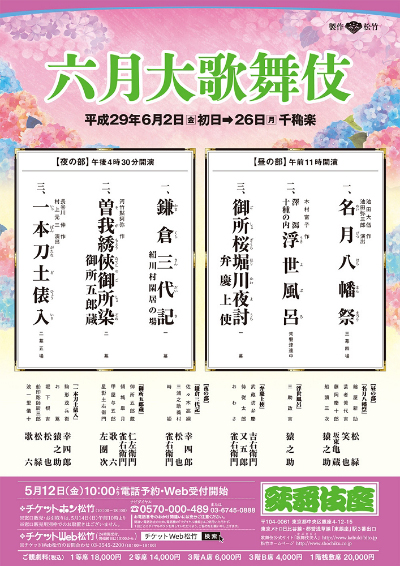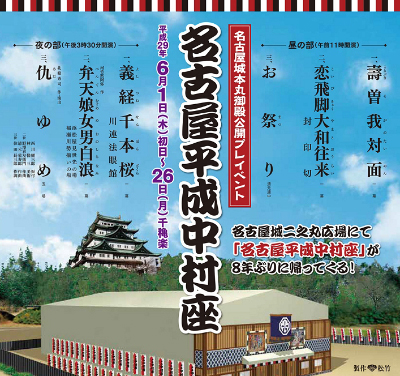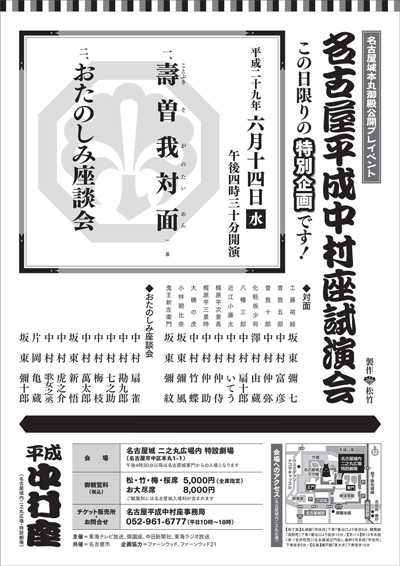| JUNE 2017 |
| Kabukiza (T˘ky˘) |  |
| Dates | 2 ~ 26 June 2017 (Rokugatsu ďkabuki) June Grand Kabuki |
| MatinÚe |
Meigetsu Hachiman Matsuri |
| Evening |
Kamakura Sandaiki |
| Casting |
Living National Treasure Nakamura Kichiemon, Living National Treasure Kataoka Nizaemon, Matsumoto K˘shir˘, Nakamura Jakuemon, Ichikawa Ennosuke, Ichikawa Sadanji, Onoe Sh˘roku, Onoe Matsuya, Nakamura Karoku, Nakamura Matagor˘, Ichikawa Emiya, Kataoka Hidetar˘, Band˘ Takesabur˘, Band˘ Kamez˘, Ichikawa Emisabur˘, Ichikawa Monnosuke, Ichikawa Komaz˘, Kamimura Kichiya, Band˘ Minosuke, Matsumoto Kingo, Ichikawa Juen, Sawamura S˘nosuke, Nakamura Kash˘, Ichikawa En'ya, ďtani Keiz˘, Sawamura Yoshijir˘, Nakamura Kichinoj˘, Kataoka Matsunosuke, Nakamura Tanenosuke, Nakamura Yonekichi, Ichikawa Otora, Ichikawa Ukon |
| Comments |
The traditional two programs for the June Grand Kabuki at the Kabukiza.
|
 |
|
|||
| Dates | 2 ~ 26 June 2017 (Rokugatsu Hakataza ďkabuki) June Hakataza Grand Kabuki |
||
| MatinÚe |
Sugawara Denju Tenarai Kagami (Kurumabiki) |
||
| Evening |
Shinshű Kawanakajima Kassen (Terutora Haizen) K˘suke Mochi |
||
| Casting |
Living National Treasure Onoe Kikugor˘, Living National Treasure Sakata T˘jűr˘, Living National Treasure Nakamura T˘z˘, Nakamura Shikan, Nakamura Tokiz˘, Nakamura Baigyoku, Nakamura Kaishun, Nakamura Ganjir˘, Onoe Kikunosuke, Nakamura Hashinosuke, Nakamura Fukunosuke, Nakamura Utanosuke, Ichikawa Danz˘, Nakamura Matsue, Nakamura Kikaku, Nakamura Kotar˘, Kawarasaki Gonjűr˘, Nakamura Jűjir˘, Ichimura Kitsutar˘, Nakamura Baika |
||
| Comments |
The traditional two programs for the June Grand Kabuki at the Hakataza. Nakamura Shikan VIII and his three sons, Nakamura Hashinosuke IV, Nakamura Fukunosuke III and Nakamura Utanosuke IV, celebrate their shűmei in Fukuoka at the Hakataza!
|
||
| Heisei Nakamuraza (Nagoya) | |
| Dates | 1 ~ 26 June 2017 |
| MatinÚe | |
| Evening |
Yoshitsune Senbon Zakura Benten Musume Meo no Shiranami
|
| Casting |
Nakamura Kankur˘, Nakamura Shichinosuke, Nakamura Senjaku, Band˘ Yajűr˘, Kataoka Kamez˘, Nakamura Baishi, Nakamura Mantar˘, Band˘ Shingo, Nakamura Toranosuke, Nakamura Kamenoj˘ |
| Comments |
The Heisei Nakamuraza is in Nagoya for the third time. The first time, it was a short stay as part of the long September 2006 tour in the western provinces. The second time occured in September 2009.
|
 |
| Heisei Nakamuraza (Nagoya) | |
| Dates | 14 June 2017 (Shienkai) Trial Session |
| Program |
Otanoshimi Zadankai |
| Comments |
A trial session within the Heisei Nakamuraza in Nagoya. Only one play is staged at 16:30 with stars' disciples in the leading roles. Otanoshimi zadankai (literally "Enjoyable Roundtable Discussion") is a stage speech with the stars performing at the Heisei Nakamuraza.
|
 |
| National Theatre (T˘ky˘) |
| Dates | 2 ~ 24 June 2017 (Rokugatsu Kabuki Kansh˘ Ky˘shitsu) June Kabuki Appreciation Class |
| Program | |
| Casting |
Nakamura Kinnosuke, Kataoka Takatar˘, ďtani Tomoemon, Band˘ Hikosabur˘, Band˘ Shűch˘, Arashi Kitsusabur˘, ďtani Hirotar˘, Nakamura Hayato, Onoe Ukon, Nakamura Umemaru |
| Comments |
Educational program at the National Theatre called Kabuki Kansh˘ Ky˘shitu ('Kabuki Appreciation Class'). This is a very interesting formula for the beginners because there is lively presentation on stage of Kabuki or some aspects of the art like music, stage tricks or fighting scenes. It is followed by the drama "Kenuki".
|
| Aichi Arts Center (Nagoya) | |
| Dates | 31 May ~ 2 June 2017 (Band˘ Tamasabur˘ x Kod˘ Tokubetsu Buy˘ K˘en) Band˘ Tamasabur˘ x Kod˘ Special Dance Performances |
| Program |
Yűgen |
| Casting |
Living National Treasure Band˘ Tamasabur˘ |
| Comments |
Living National Treasure Band˘ Tamasabur˘ performs in Nagoya at the Aichi Arts Center along with the Kod˘ taiko drummers in a newly-created dance-drama entitled "Yűgen", which features an array of classical Japanese images from plays by N˘ founder Zeami Motokiyo, incorporating themes from iconic works such as "Hagoromo" (The Feather Robe), "D˘j˘ji" (D˘j˘ji Temple) and "Shakky˘" (The Stone Bridge). Band˘ Tamasabur˘ shares the stage with the dance master Hanayagi Jusuke IV and his disciples. |
| Tango Bunka Kaikan (Ky˘tango) | |
| Dates | 24 ~ 25 June 2017 (Band˘ Tamasabur˘ Tokubetsu Buy˘ K˘en) Band˘ Tamasabur˘ Special Dance Performances |
| Program |
Aki no Irokusa |
| Casting |
Living National Treasure Band˘ Tamasabur˘ |
| Comments |
A special Buy˘ program starring the amazing Living National Treasure onnagata Band˘ Tamasabur˘ in Ky˘tango at the Tango Bunka Kaikan (Tango Culture Center). A place named Mineyama, now part of Ky˘tango, had a close connection with the Hagoromo legend.
|
|
|||
| Dates | 9 ~ 25 June 2017 (ABKAI2017) Ebikai 2017 |
||
| Program |
Ishikawa Goemon Gaiden |
||
| Casting |
Ichikawa Ebiz˘, Ichikawa Udanji, Kataoka Ichiz˘, Nakamura Kazutar˘, ďtani Hiromatsu, Ichikawa Kudanji, Nakayama Yűma, Maeno Tomoya, Yamada Jundai |
||
| Comments |
Fourth edition of the ABKAI (Ebikai in Japanese), a gala for the young star Ichikawa Ebiz˘. |
||
|
|
| Contact | Main | Top | Updates | Actors | Plays | Playwrights | Programs | Links | FAQ | Glossary | Chronology | Illustrations | Prints | Characters | Derivatives | Theaters | Coming soon | News |

